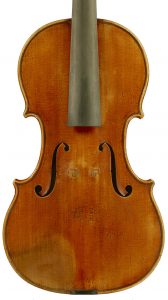Discovered the technical fingerprint of the traditional Cremonese violin makers
|Cremonese traditional luthiery is one of the most renowned artisanal legacies in the world. Between the XVI and the XVIII century families like the Guarneri and the Stradivari built instruments that became legendary, recognised now, centuries later, among the most valuable instruments in the world. The value of traditional violin craftsmanship in Cremona has also been declared an intangible cultural heritage by UNESCO in 2012, and several scientific studies focused their attention on these instruments. The intent of these research works is to understand what makes these pieces unique and to discover secrets that could have been lost in the centuries.

Giacomo Fiocco, CERIC user from the University of Turin and the Arvedi laboratory of non-invasive diagnostics at the University of Pavia, and his colleagues, recently published an article about their analyses on traditional Cremonese violins. Among the items that the scientists analysed, there are “Toscano”, manufactured by Antonio Stradivari in 1690, and “Bracco”, created by Lorenzo Storioni in 1793. The study, in which were also involved Dr. Monica Gulmini (University of Turin) and Prof. Marco Malagodi (University of Pavia), highlighted the technical fingerprint of the two Cremonese masters, which appeared different. Storioni’s violins, for example, appear to be characterised by a 10-micrometer ground coat covered by a 60-90 micrometers varnishing layer, while for Stradivari’s the varnishing layer was 10-15 micrometers thick. In this last case, no ground coat was detected, but it probably penetrated in the wood pores.
The analysis was carried on micrometric samples detached from the violin employing synchrotron infrared radiation at SISSI beamline at the Italian CERIC partner facility. Non-destructive techniques, such as the ones available at CERIC’s partner facilities, are of fundamental importance for the study of cultural heritage items and allow, at the same time, to improve our knowledge of ancient techniques, and to preserve unique pieces of art and craftsmanship.
Below the speech given by Giacomo Fiocco at ESOF2020 in Trieste (in Italian)



